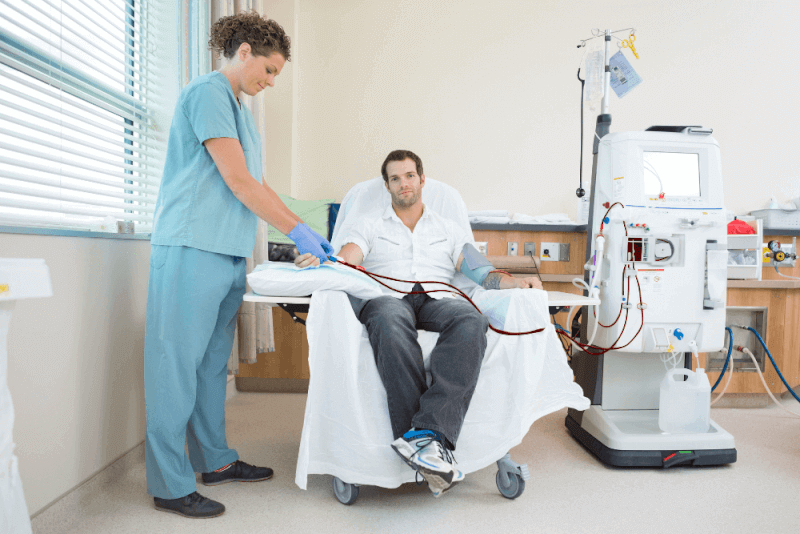30 Second Summary
- Nephrotic syndrome is a condition in which the kidneys excrete too much protein in the urine.
- Nephrotic syndrome can have many different causes, but the most common cause is damage to the small blood vessels (glomeruli) in the kidneys.
- Symptoms of nephrotic syndrome include swelling, high blood pressure, the presence of protein in the urine and low blood albumin levels.
- Treatment of nephrotic syndrome depends on the underlying cause, but usually involves medication and dietary changes.
What is nephrotic syndrome?
A condition in which the kidneys release too much protein in the urine is called nephrotic syndrome. It is usually caused by a disease of the filters in the kidneys. These filters in the kidneys are called glomeruli and are made up of small blood vessels. This removes waste and excess fluids from the blood and sends them to the bladder as urine. The waste usually contains nitrogen waste (urea), acids and muscle waste (creatine).
In a healthy filtration system, only waste is filtered. This keeps cells and proteins in the blood that keep the body functioning properly. However, if there is a problem with the filtering system, damaged glomeruli cause proteins in the blood, including albumin, to leak into the urine.
People with nephrotic syndrome leak 3 or more grams of protein in a 24-hour urinalysis. This amount is 20 times higher than the amount seen in a healthy person.
Nephrotic syndrome can cause various problems in the body due to the loss of different proteins. Some of these proteins are proteins that help prevent blood clotting. Therefore, insufficient amounts of these proteins in the blood can cause blood clotting.
In addition, the immunoglobulins excreted with nephrotic syndrome are part of the immune system and help the body fight infections. Loss of immunoglobulins increases the risk of pneumonia, cellulitis and peritonitis.
Diagnostic methods for nephrotic syndrome
Among the tests that can be used to detect nephrotic syndrome are the following.
Urinalysis
Urinalysis involves chemical, visual and microscopic examination of urine. For this reason, several different urine tests are performed. Among these tests, the dipstick test is the most preferred because it is easy to apply. In the dipstick test, a strip of paper coated with special chemicals is placed in the urine sample. A discoloration of the paper strip indicates albumin in the urine.
If more precise information is needed, the urine sample is sent to the laboratory. Samples can be collected once or urine samples collected for 24 hours can also be used in the tests. These tests compare the proportions of keratin and albumin in urine samples. If the results show 30 mg or more of albumin per gram of sample, it is considered a sign of a problem.
If a 24-hour urine sample is requested for the test, patients should do the following during urine collection:
- On the first day, patients should urinate in the toilet when they wake up.
- They should urinate the rest of the day in the specimen container.
- When they first wake up the next day, they should urinate again in the specimen container. The urine sample is then delivered to the laboratory.
Blood tests
Blood tests examine albumin and other proteins in the blood. If the levels of these proteins in the blood are low, it is considered an indicator of nephrotic syndrome. Patients are also tested for cholesterol and blood triglycerides. Because these values are normally higher in people with low albumin levels.
Kidney biopsy
In a kidney biopsy, a small piece of the patient's kidney is taken and examined under a microscope. Patients are given local anesthesia to take the biopsy sample. Patients are also given a mild sedative to help them relax. In this way, patients are advised not to feel any pain or soreness. A biopsy needle is used in the procedure.
People with diabetes do not need a kidney biopsy. Old medical knowledge, blood and urine tests are sufficient. Because diabetes is one of the factors that cause nephrotic syndrome.
Symptoms of nephrotic syndrome
Symptoms caused by nephrotic syndrome usually show up in blood and urine tests. Patients may also experience abdominal pain or weakness. Other symptoms of nephrotic syndrome include the following:
- More than 3.5 grams of protein in the urine
- High levels of cholesterol and fats in the blood
- Low levels of protein in the blood
- Edema, usually in the legs and ankles
- Swelling in the hands and face
- Loss of appetite
- Foamy urine
- Osteoporosis
- Loss of vitamins and minerals
Complications of nephrotic syndrome
The most common complications of nephrotic syndrome are the following.
- The thyroid gland cannot produce enough thyroid hormone and release it into the bloodstream. This results in hypothyroidism.
- Hypertension
- Coronary artery disease caused by plaque buildup in blood vessels
- Anemia
- Acute kidney injury occurs when the kidneys suddenly stop working properly.
- Formation of blood clots
- High cholesterol and blood triglycerides
- Poor nutrition
- High blood pressure
- Chronic kidney disease
- Infection
Causes of nephrotic syndrome
The main cause of nephrotic syndrome is kidney disease that causes damage to the glomeruli. Research has not yet been able to prove exactly why the diseases cause damage to the filtering systems of the kidneys. Among the diseases that cause nephrotic syndrome are the following:
Amyloidosis
Amyloidosis, which causes protein deposits in vital organs, is most common in the kidneys. This affects the filtering ability of the kidneys.
Diabetes-associated nephropathy
Nephropathy is a term for a kidney that is not working properly. In diabetes-related nephropathy, there is damage or dysfunction of the nerves in the kidneys. As the nerves are affected, numbness, tingling, pain and muscle weakness are observed on the side of the damaged nerve.
Focal segmental glomerulosclerosis (FSGG)
In renal injuries, small areas of the glomeruli are affected. This leads to kidney failure, swelling of the kidneys and protein loss.
Lupus
Lupus is a disease that causes inflammation throughout the body, including the kidneys. Lupus, one of the autoimmune diseases, causes edema and pain in the body.
Membranous nephropathy
In membranous nephropathy, it is the body's immune system that damages the filtering system of the kidneys. This attack causes damage to the filtering system.
Minimal change disease (MCD)
In MCD, a disease in which the kidneys fail to function properly, a kidney biopsy shows little or no damage to the kidney tissues and glomeruli. MCD, a disease that can be seen in all age groups, is especially seen in children.
Nephrotic syndrome treatment methods
There is no cure for nephrotic syndrome. On the other hand, nephrotic syndrome in children resolves spontaneously during adolescence or in their early 20s. There are also treatments to control the symptoms of nephrotic syndrome. These treatments prevent further damage to the kidneys.
When planning the treatment of nephrotic syndrome, treatment of the underlying underlying disease is targeted. In addition, treatments are planned to control swelling, high blood pressure, infection and high cholesterol. This treatment plan usually includes medications and dietary changes.
Blood pressure lowering drugs
Some blood pressure medications reduce the pressure on the glomeruli. These drug groups include ACE inhibitors and ARBs. Patients often need two or more blood pressure medications to regulate their blood pressure.
Diuretic drugs
Patients with nephrotic syndrome may be prescribed diuretics as well as blood pressure regulators. These medicines help to remove fluid from the blood. This regulates blood pressure and reduces edema in the body. This group of drugs includes beta-blockers and calcium channel blockers.
Cholesterol medicines
Cholesterol medications are also prescribed to lower the high cholesterol seen in patients with nephrotic syndrome. This group of medicines includes statin medicines.
Other treatment tools
It is recommended that people with nephrotic syndrome receive regular annual flu and pneumococcal vaccinations. The pneumococcal vaccine not only helps protect the body from pneumonia, but also from ear infections, sore throats and meningitis.
Some patients may also be prescribed blood thinners. Blood thinners are given to patients who form blood clots. Because this medicine does not prevent the symptoms of nephrotic syndrome.
Nephrotic syndrome nutrition
Diet is not effective in treating nephrotic syndrome in adults. However, some dietary changes can alleviate symptoms. The most important of these is limiting sodium to reduce edema in the body. In addition, increasing fluid consumption will also help to remove edema in the body.
In order to reduce the cholesterol level in the blood, which is another symptom of nephrotic syndrome, it is necessary to eliminate foods containing born fat from the diet. These include red meat, high-fat dairy products, processed meat, fried foods, sweets and baked goods.







